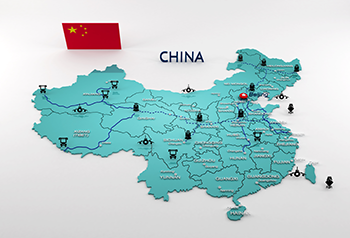
In China, regional governments are authorized to set their own minimum wages according to local conditions. If adjustments to minimum wages are made, they usually occur in the first half of the year. However, the cities of Shanghai and Shenzhen and the provinces of Shandong, Fujian, and Shaanxi are the only jurisdictions that have done so in 2017.
Authorities in these five jurisdictions all increased their minimum wage levels. Although other regions still have ample opportunity to adjust their wages in 2017, the reluctance of a majority of provinces to increase wages in the first half of the year reflects the nationwide concern to keep wage growth in check in order to maintain competitiveness, particularly as China’s economy slows.
Employers in the affected regions must take into account the revised wage standards, as well as social insurance and other forms of employee compensation that may be tied to wages in a given location. Investors in labor-intensive industries also should review the latest minimum wage adjustments to understand payroll trends that could affect their businesses. More details about the increases in the five jurisdictions are below:
Shanghai
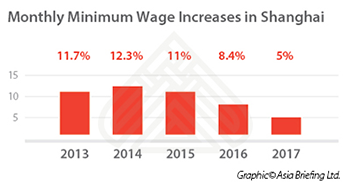 The Shanghai municipal government raised minimum wages earlier this year, effective as of April 1. The monthly minimum wage was elevated by 5%, from Renminbi (RMB) 2,190 to RMB 2,300, while the hourly minimum wage increased from RMB 19 to RMB 20.
The Shanghai municipal government raised minimum wages earlier this year, effective as of April 1. The monthly minimum wage was elevated by 5%, from Renminbi (RMB) 2,190 to RMB 2,300, while the hourly minimum wage increased from RMB 19 to RMB 20.
Although Shanghai has increased its minimum wage each year since wage hikes were frozen in 2009, the 5% increase is lower than in previous years. Nevertheless, Shanghai still has the highest monthly and hourly minimum wages in China.
Shenzhen
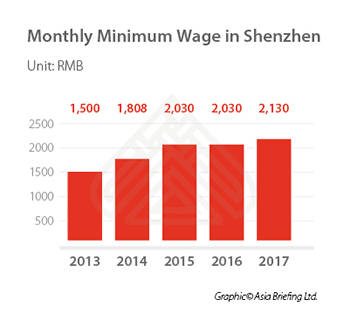 Shenzhen has increased its minimum wage for the first time since 2015. The monthly minimum wage has increased from RMB 2,030 to RMB 2,130, and the hourly minimum wage from RMB 18.5 to RMB 19.5. The changes took effect on April 1.
Shenzhen has increased its minimum wage for the first time since 2015. The monthly minimum wage has increased from RMB 2,030 to RMB 2,130, and the hourly minimum wage from RMB 18.5 to RMB 19.5. The changes took effect on April 1.
With the increase, Shenzhen continues to have the second highest minimum wage in China, trailing only Shanghai.
There is no minimum wage increase for the rest of Guangdong Province, as provincial authorities put a freeze on minimum wage hikes for 2016 and 2017.
Shenzhen autonomously sets its own wages, separate from Guangdong Province.
Shandong Province
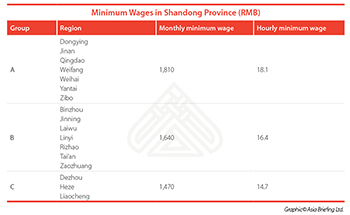 Shandong provincial authorities announced on May 26 that the province will increase minimum wages, effective June 1. Shandong also increased its minimum wage last year.
Shandong provincial authorities announced on May 26 that the province will increase minimum wages, effective June 1. Shandong also increased its minimum wage last year.
Minimum wage standards in Shandong are divided into three groups, depending on the region’s stage of development:
- Group A monthly minimum wages have been increased by RMB 100 to RMB 1,810. Hourly minimum wages have increased to RMB 18.1 (increase of RMB 0.9).
- Group B monthly minimum wages increased by RMB 90 to RMB 1,640. Hourly minimum wages have increased to RMB 16.4 (increase of RMB 1).
- Group C monthly minimum wages increased by RMB 80 to RMB 1,470. Hourly minimum wages have increased to RMB 14.7 (increase of RMB 0.8).
Fujian Province
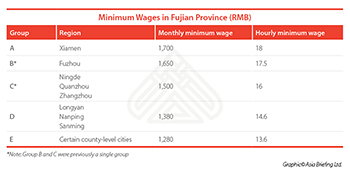 The Fujian provincial government recently announced minimum wage changes, also the province’s first since 2015. Besides increasing wages, the update divides what was previously Group B into two separate groups, thereby increasing the number of wage groups from four to five. Fuzhou is now alone in Group B, while Ningde, Quanzhou, and Zhangzhou occupy Group C.
The Fujian provincial government recently announced minimum wage changes, also the province’s first since 2015. Besides increasing wages, the update divides what was previously Group B into two separate groups, thereby increasing the number of wage groups from four to five. Fuzhou is now alone in Group B, while Ningde, Quanzhou, and Zhangzhou occupy Group C.
Dividing Group B—which previously had a monthly minimum wage of RMB 1,350—into two separate groups helps Fujian keep wages in line with local conditions. With the new scheme, the wealthier provincial capital Fuzhou enjoys a higher minimum wage of RMB 1,650, while the slightly less developed cities in Group C have a lower minimum wage of RMB 1,500.
Shaanxi Province
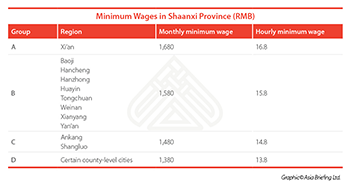 Shaanxi Province also has adjusted its minimum wage for the first time since 2015. The monthly minimum wages are:
Shaanxi Province also has adjusted its minimum wage for the first time since 2015. The monthly minimum wages are:
- Group A has increased its monthly minimum wage from RMB 1,480 to RMB 1,680. Hourly minimum wages increased from RMB 14.8 to RMB 16.8.
- Group B has increased its monthly minimum wage from RMB 1,370 to RMB 1,580. Hourly minimum wages increased from RMB 13.7 to 15.8.
- Group C has increased its monthly minimum wage from RMB 1,260 to RMB 1,480. Hourly minimum wages increased from RMB 12.6 to RMB 14.8.
- Group D has increased its monthly minimum wage from RMB 1,190 to RMB 1,480. Hourly minimum wages increased from RMB 11.9 to RMB 13.8.
The changes took effect on May 1.
Slowing Wage Increases
So far, only five regions—Shenzhen, Shandong, Fujian, Shaanxi, and Shanghai—have increased their minimum wages in 2017. At a similar point in 2016, nine regions had already adjusted their minimum wages, while 27 had already done so in 2015. Of the regions increasing wages, only Shanghai and Shandong also increased wages the previous year.
In 2016, China’s Ministry of Human Resources and Social Security (MOHRSS) gave provinces more independence and flexibility in determining minimum wages. Previously, provinces had to adjust their minimum wages at least once every two years.
Factors such as economic growth, average wages, the cost of living, and housing prices affect the calculation of minimum wages. As wages in China have sharply risen over the past several years and growth has slowed, it appears as though many provinces are freezing wage increases to maintain their competitiveness—both within the country as well as vis-à-vis locations in ASEAN and India.
Despite these efforts, fewer and fewer workers in China are being paid at the minimum levels. With an aging labor pool and a growing demand for skilled workers, wages in China are steadily increasing. In 2016, the average monthly salary in 34 leading Chinese cities was RMB 7,606.
Although provinces are trying to put the brakes on rapid wage growth, China’s demographic and macro-economic changes suggest that average wages will continue to increase at a steady rate.
Original article posted by China Briefing. Since its establishment in 1992, Dezan Shira & Associates has been guiding American investors through Asia’s complex regulatory environment and assisting them with all aspects of legal, accounting, tax, internal control, HR, payroll, and audit matters. As a full-service consultancy with operational offices across China, Hong Kong, India, and emerging ASEAN, including liaison offices in Boston and Waltham specifically established to support our American clients, we are your reliable partner for business expansion in Asia and beyond. For inquiries, email us at [email protected]. For further information about our firm and how we can support American investors in Asia, visit our North American Desk.
 Adam Livermore is an equity partner at Dezan Shira & Associates. He manages Dezan Shira & Associates’ Dalian, Qingdao, and India offices, while leading the team providing integrated payroll processing services to clients across China, Vietnam, India, Hong Kong, and Singapore. He also has a particular specialization in the area of human resources in China.
Adam Livermore is an equity partner at Dezan Shira & Associates. He manages Dezan Shira & Associates’ Dalian, Qingdao, and India offices, while leading the team providing integrated payroll processing services to clients across China, Vietnam, India, Hong Kong, and Singapore. He also has a particular specialization in the area of human resources in China.